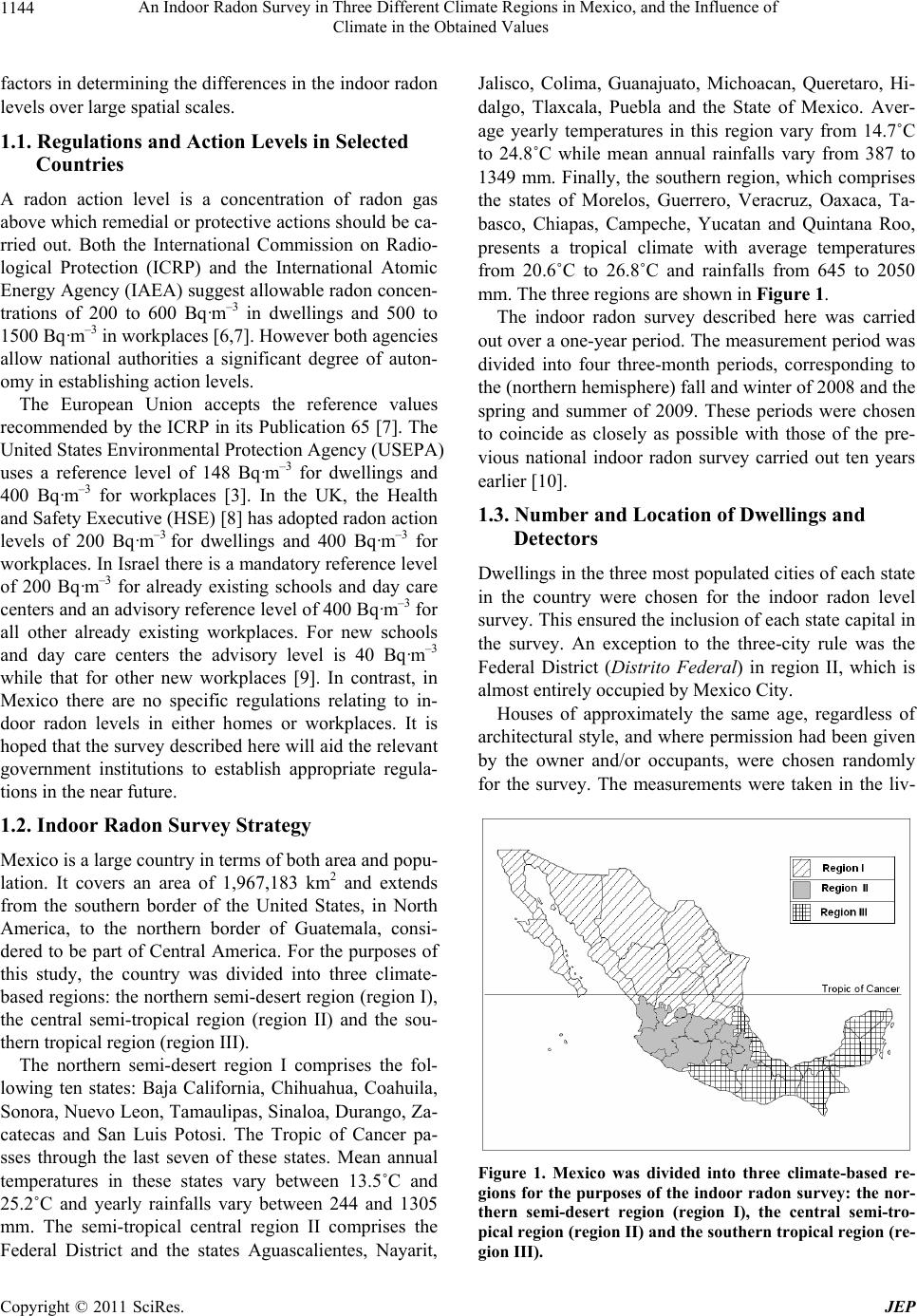
An Indoor Radon Survey in Three Different Climate Regions in Mexico, and the Influence of
1144 Climate in the Obtained Values
factors in determining th e differences in the in door radon
levels over large spatial scales.
1.1. Regulations and Action Levels in Selected
Countries
A radon action level is a concentration of radon gas
above which remedial or protective actions should be ca-
rried out. Both the International Commission on Radio-
logical Protection (ICRP) and the International Atomic
Energy Agency (IAEA) suggest allowable radon concen-
trations of 200 to 600 Bq·m–3 in dwellings and 500 to
1500 Bq·m–3 in workplaces [6,7]. However both agencies
allow national authorities a significant degree of auton-
omy in establishing action levels.
The European Union accepts the reference values
recommended by the ICRP in its Publication 65 [7]. Th e
United States Environmental Protection Agency (USEPA)
uses a reference level of 148 Bq·m–3 for dwellings and
400 Bq·m–3 for workplaces [3]. In the UK, the Health
and Safety Executive (HSE) [8] h as adopted radon action
levels of 200 Bq·m–3 for dwellings and 400 Bq·m–3 for
workplaces. In Israel there is a mandatory reference level
of 200 Bq·m–3 for already existing schools and day care
centers and an advisory reference level of 400 Bq·m–3 for
all other already existing workplaces. For new schools
and day care centers the advisory level is 40 Bq·m–3
while that for other new workplaces [9]. In contrast, in
Mexico there are no specific regulations relating to in-
door radon levels in either homes or workplaces. It is
hoped that the survey d escribed here will aid the relev ant
government institutions to establish appropriate regula-
tions in the near fu ture.
1.2. Indoor Radon Survey Strategy
Mexico is a large country in terms of both area and popu-
lation. It covers an area of 1,967,183 km2 and extends
from the southern border of the United States, in North
America, to the northern border of Guatemala, consi-
dered to be part of Central America. For the purposes of
this study, the country was divided into three climate-
based regions: the nor thern semi-desert region (region I),
the central semi-tropical region (region II) and the sou-
thern tropical r e gi o n (re gi o n III).
The northern semi-desert region I comprises the fol-
lowing ten states: Baja California, Chihuahua, Coahuila,
Sonora, Nuevo Leon, Tamaulipas, Sinaloa, Durango, Za-
catecas and San Luis Potosi. The Tropic of Cancer pa-
sses through the last seven of these states. Mean annual
temperatures in these states vary between 13.5˚C and
25.2˚C and yearly rainfalls vary between 244 and 1305
mm. The semi-tropical central region II comprises the
Federal District and the states Aguascalientes, Nayarit,
Jalisco, Colima, Guanajuato, Michoacan, Queretaro, Hi-
dalgo, Tlaxcala, Puebla and the State of Mexico. Aver-
age yearly temperatures in this region vary from 14.7˚C
to 24.8˚C while mean annual rainfalls vary from 387 to
1349 mm. Finally, the southern region, which comprises
the states of Morelos, Guerrero, Veracruz, Oaxaca, Ta-
basco, Chiapas, Campeche, Yucatan and Quintana Roo,
presents a tropical climate with average temperatures
from 20.6˚C to 26.8˚C and rainfalls from 645 to 2050
mm. The three regions are shown in Figure 1.
The indoor radon survey described here was carried
out over a one-year period. The measurement period was
divided into four three-month periods, corresponding to
the (northern hemisphere) fall and winter of 2008 and the
spring and summer of 2009. These periods were chosen
to coincide as closely as possible with those of the pre-
vious national indoor radon survey carried out ten years
earlier [10].
1.3. Number and Location of Dwellings and
Detectors
Dwellings in the three most populated cities of each state
in the country were chosen for the indoor radon level
survey. This ensured the inclusion of each state capital in
the survey. An exception to the three-city rule was the
Federal District (Distrito Federal) in region II, which is
almost entirely occupied by Mexico City.
Houses of approximately the same age, regardless of
architectural style, and where permission had been given
by the owner and/or occupants, were chosen randomly
for the survey. The measurements were taken in the liv-
Figure 1. Mexico was divided into three climate-based re-
gions for the purposes of the indoor radon survey: the nor-
thern semi-desert region (region I), the central semi-tro-
pical region (region II) and the southe rn tropic al region (re -
gion III).
C
opyright © 2011 SciRes. JEP